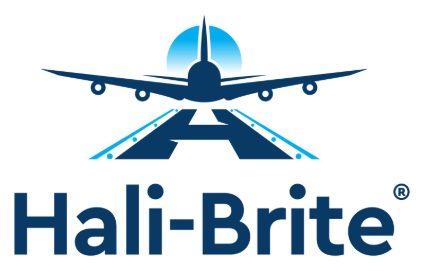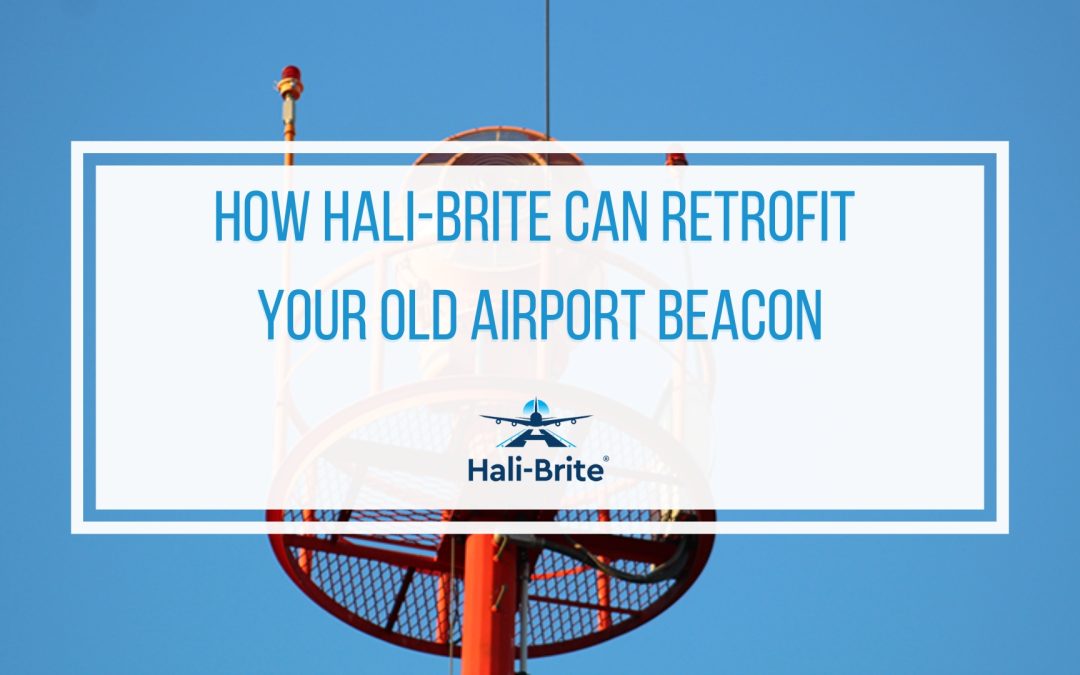When you’re on final approach in low visibility or navigating unfamiliar skies at night, the steady blink of an airport beacon is often the first sign that you’re headed to the right place. These rotating airport beacon lights help pilots identify the location of an airfield, signal whether it is a civilian or military aerodrome, and provide a visual aid that supplements instrument procedures.
- Challenges with Legacy Airport Beacon Lights
- Hali-Brite’s Advanced Solutions for Upgrading Airport Beacons
- The Retrofitting Process: Assessment, Customization, and Implementation
- Light Up the Future with Upgraded Airport Beacon Lights
Over decades of service, however, many beacons have drifted behind the times. Metal‑halide bulbs gulp electricity, motors wear down, and older housings struggle to meet updated Federal Aviation Administration (FAA) standards and specifications. Let’s explore the common challenges with legacy airport beacons and how Hali-Brite can provide innovative, future-ready solutions to keep your airport operating at its best.
Challenges with Legacy Airport Beacon Lights
Legacy airport beacon lights often face several recurring problems that impact not just the equipment itself but overall airport operations. Here are the most common issues:
Frequent Maintenance
Older beacons rely on metal‑halide or incandescent lamps that burn out quickly and generate intense heat. Crews climb towers more often, and replacement parts for decades‑old gearboxes or belt drives are getting harder to source.
High Energy Consumption
A conventional metal‑halide beacon consumes significantly more power than modern LED systems, resulting in increased operational expenses, an issue magnified at regional airports that also run obstruction lights and approach systems.
Diminished Visibility
Lamp lumen output degrades over time. In fog, heavy rain, or snow, the weakened beam might scatter instead of cutting through to the horizon, making it harder for pilots to pick up the airfield during approaches.
Compliance Gaps
As FAA guidelines continue to evolve, older airport beacon lights might no longer comply with updated safety and performance benchmarks, which can lead to regulatory issues and limit certification or future expansion plans of an airport.
Operational Effects
When a beacon fails, the Air Traffic Control (ATC) must issue a Notice to Airmen (NOTAM) of the outage and dispatch maintenance. Pilots lose an extra layer of situational awareness, and operations staff absorb overtime costs to restore service.
Hali-Brite’s Advanced Solutions for Upgrading Airport Beacons
Hali-Brite offers comprehensive, future-focused solutions that can improve every aspect of your airport beacon systems. Here’s how our upgrades make a difference:
-
- Improved Brightness
High‑output LEDs provide an intense, consistent beam that meets FAA photometry requirements, improving detection range in harsh weather or low-light conditions.
-
- Energy Efficiency
Our Airport LED Rotating Beacon L-801A(L) uses up to 65% less power than traditional incandescent lamps, translating into long-term cost savings and a smaller environmental footprint.
-
- Reliable, Instant-On Performance
LED beacon systems hit full brightness the moment you flip the breaker—no more 3‑ to 5‑minute warm‑up while the filament stabilizes. That’s critical after storm‑related power bumps.
-
- Longer Lifespan
Both our L-801A(L) and L-802A(L) models boast a 50,000-hour typical lamp life—that’s about 12 years of operation. Fewer replacements mean lower maintenance demands and reduced disruption.
-
- Smart Monitoring Options
An optional tell‑tale relay senses lamp status and feeds a dry‑contact alarm to your airfield lighting control system, letting you know a beacon lamp has failed before a pilot does.
-
- Easy Maintenance
Field maintenance is safest on the ground. Our Beacon Tipdown Pole lets a single technician lower the beacon head with a hand winch, perform service at waist level, and raise it again in minutes.
We can assess your current setup, recommend the best retrofitting solutions, and help you implement upgrades that boost performance while keeping costs under control.
The Retrofitting Process: Assessment, Customization, and Implementation
Hali-Brite follows a streamlined, customized process to ensure every retrofit fits seamlessly with the existing setup of your airport. Here’s how it works:
-
- Site Assessment
Our technicians review the beacon model, tower height, power feed, and photometric performance, then document any corrosion or structural issues that could complicate an upgrade.
-
- Customized Design
Using the collected data, Hali‑Brite selects the appropriate LED light engines, drive motors, and control modules, ensuring full compatibility with FAA requirements and any state or International Civil Aviation Organization (ICAO) overlays.
-
- Project Planning
Working with airport operations, our experienced team picks installation windows, often during nighttime closures or low‑traffic periods, to minimize service disruption.
-
- On‑Tower Installation
Our airport lighting equipment installers remove legacy lamps and ballasts, drop in the LED assemblies, align optics, and wire in the tell‑tale relay or remote‑on interface if required.
-
- Functional Testing
After powering up, our technicians verify rotation speed, flash signature, and color wavelengths with portable photometers, documenting results for your Part 139 Airport Certification.
Throughout the process, the focus is on keeping your airfield lit. Most retrofits are completed in one shift, ensuring continuous pilot guidance.
Light Up the Future with Upgraded Airport Beacon Lights
Reliable airport beacons are frontline safety equipment that gives every pilot confidence on dark or stormy approaches. With Hali‑Brite, you can replace aging components with cutting-edge technology, ensuring your airport beacon lights exceed FAA and ICAO standards of today and stay ready for the demands of tomorrow.
Our expert team works closely with airport staff to guarantee that each upgrade is smooth, cost-effective, and tailored to your specific needs. If you’re ready to modernize your airport beacon system, contact us today at (218) 454-095 or here to discuss your retrofit options and see how easy it is to light up the future of your airfield.


